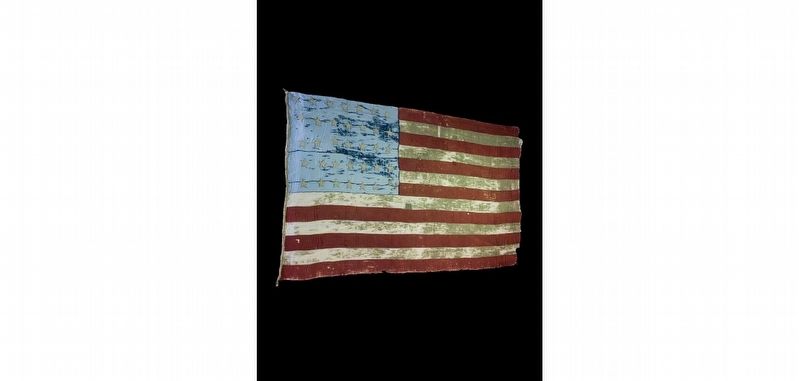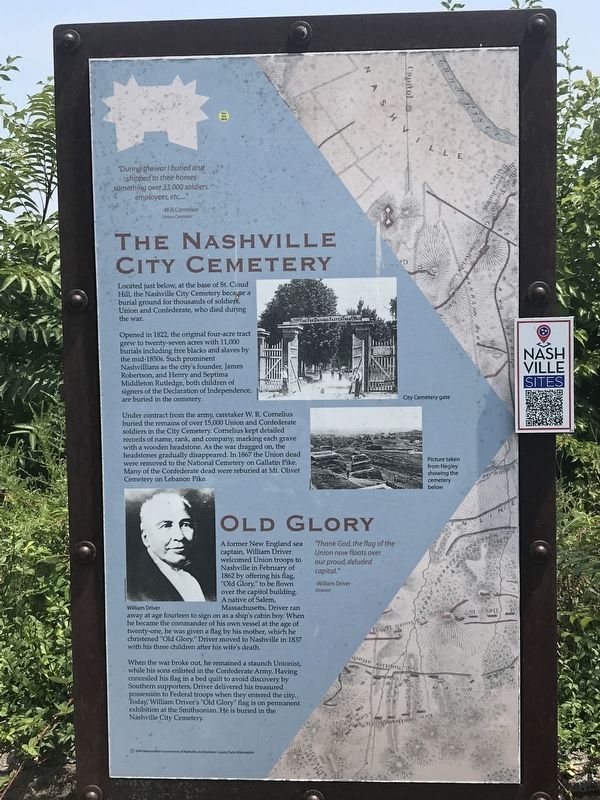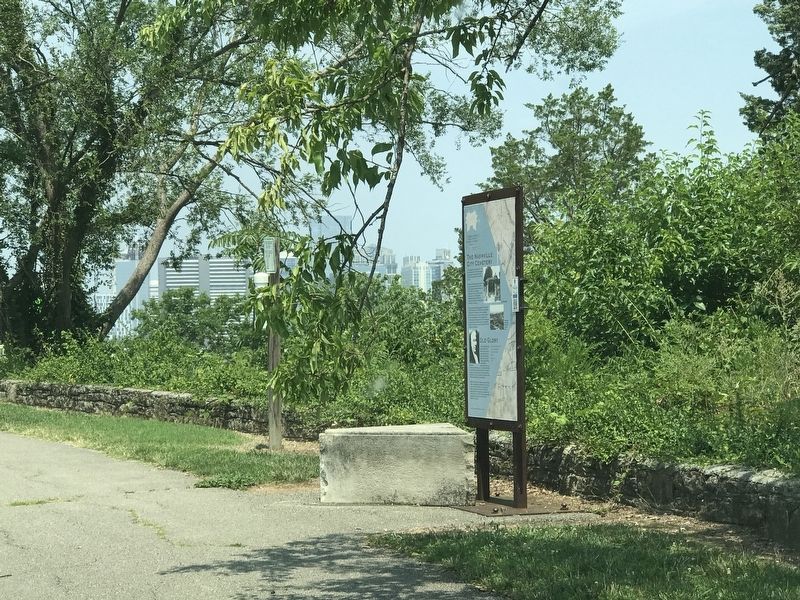South Nashville in Davidson County, Tennessee — The American South (East South Central)
The Nashville City Cemetery / Old Glory
Inscription.
"During the war I buried and shipped to their homes something over 33,000 soldiers, employees, etc.." — -W.R. Cornelius, Union CaretakerThe Nashville City Cemetery
Located just below, at the base of St. Cloud Hill, the Nashville City Cemetery became a burial ground for thousands of soldiers, Union and Confederate, who died during the war.
Opened in 1822, the original four-acre tract grew to twenty-seven acres with 11,000 burials including free blacks and slaves by the mid-1850s. Such prominent Nashvillians as the city's founder, James Robertson, and Henry and Septima Middleton Rutledge, both children of signers of the Declaration of Independence, are buried in the cemetery.
Under contract from the army, caretaker W. R. Cornelius buried the remains of over 15,000 Union and Confederate soldiers in the City Cemetery. Cornelius kept detailed records of name, rank, and company, marking each grave with a wooden headstone. As the war dragged on, the headstones gradually disappeared. In 1867 the Union dead were removed to the National Cemetery on Gallatin Pike. Many of the Confederate dead were reburied at Mt. Olivet Cemetery on Lebanon Pike.
Old Glory
"Thank God, the flag of the Union now floats over our proud, deluded capital." — William Driver, UnionistA former New England sea captain, William Driver welcomed Union troops to Nashville in February of 1862 by offering his flag, "Old Glory,” to be flown over the capitol building. A native of Salem, Massachusetts, Driver ran away at age fourteen to sign on as a ship's cabin boy. When he became the commander of his own vessel at the age of twenty-one, he was given a flag by his mother, which he christened "Old Glory." Driver moved to Nashville in 1837 with his three children after his wife's death.
When the war broke out, he remained a staunch Unionist, while his sons enlisted in the Confederate Army. Having concealed his flag in a bed quilt to avoid discovery by Southern supporters, Driver delivered his treasured possession to Federal troops when they entered the city. Today, William Driver's "Old Glory" flag is on permanent exhibition at the Smithsonian. He is buried in the Nashville City Cemetery.
Captions (top to bottom)
• City Cemetery gate.
• Picture taken from Negley showing the cemetery below.
• William Driver
Erected 2004 by Metropolitan Government of Nashville and Davidson County Parks & Recreation.
Topics. This historical marker is listed in these topic lists: Cemeteries & Burial Sites • War, US Civil.
Location.
36° 8.747′ N, 86° 46.409′ W. Marker is in Nashville, Tennessee, in Davidson County. It is in South Nashville. Marker can be reached from Fort Negley Boulevard north of Chestnut Street, on the right when traveling north. Marker is alongside the outer loop around Fort Negley. Going counterclockwise on the trail, the marker is about 0.2 miles from the park entrance. Touch for map. Marker is at or near this postal address: 1100 Fort Negley Boulevard, Nashville TN 37203, United States of America. Touch for directions.
Other nearby markers. At least 8 other markers are within walking distance of this marker. Samuel R. Lowery (within shouting distance of this marker); Captain James St. Clair Morton (within shouting distance of this marker); Andrew Johnson (within shouting distance of this marker); Building Fort Negley / African American Labor (about 300 feet away, measured in a direct line); A Birthplace of Freedom (about 400 feet away); Sally Port (about 400 feet away); Union Major General Don Carlos Buell (about 400 feet away); Fortress Nashville / Forts (about 500 feet away). Touch for a list and map of all markers in Nashville.

Photographed By Mary J. D. Roland / Smithsonian Institution
3. "Old Glory"
From the Smithsonian: "The name 'Old Glory' was loudly proclaimed in 1824 by Captain William Driver as he hoisted the flag given to him as a birthday present. The flag would accompany Driver on his numerous voyages around the world. When he gave up seafaring and moved inland to Nashville, Tennessee in 1837, Driver continued to display the flag proudly by hanging it from a locust tree. He even updated the flag in 1861 to reflect thirty-four stars and added an anchor in the corner to indicate his sea service. When Tennessee seceded from the Union, Driver had the foresight to hide the flag and had his daughter conceal it inside a quilt, which was overlooked in numerous raids on his house. Old Glory remained in the quilt until February 25, 1862 when Ulysses S. Grant captured Fort Donelson and occupied Nashville. On that day Driver uncovered the flag, marched through the streets to the capitol building, climbed to its dome, and hoisted the flag for all to see."
Credits. This page was last revised on February 7, 2023. It was originally submitted on August 1, 2021, by Duane and Tracy Marsteller of Murfreesboro, Tennessee. This page has been viewed 187 times since then and 13 times this year. Photos: 1, 2, 3. submitted on August 1, 2021, by Duane and Tracy Marsteller of Murfreesboro, Tennessee.

